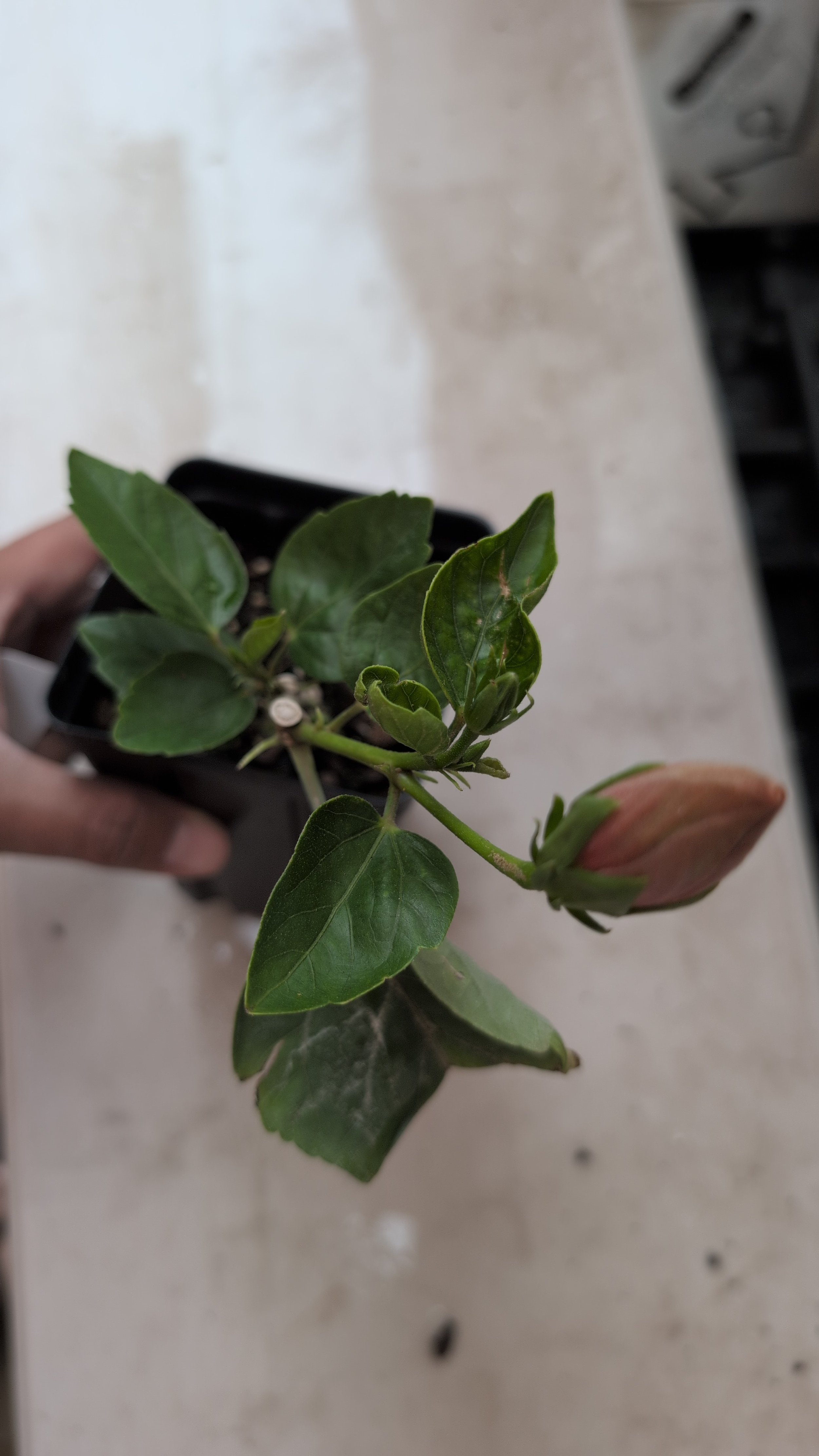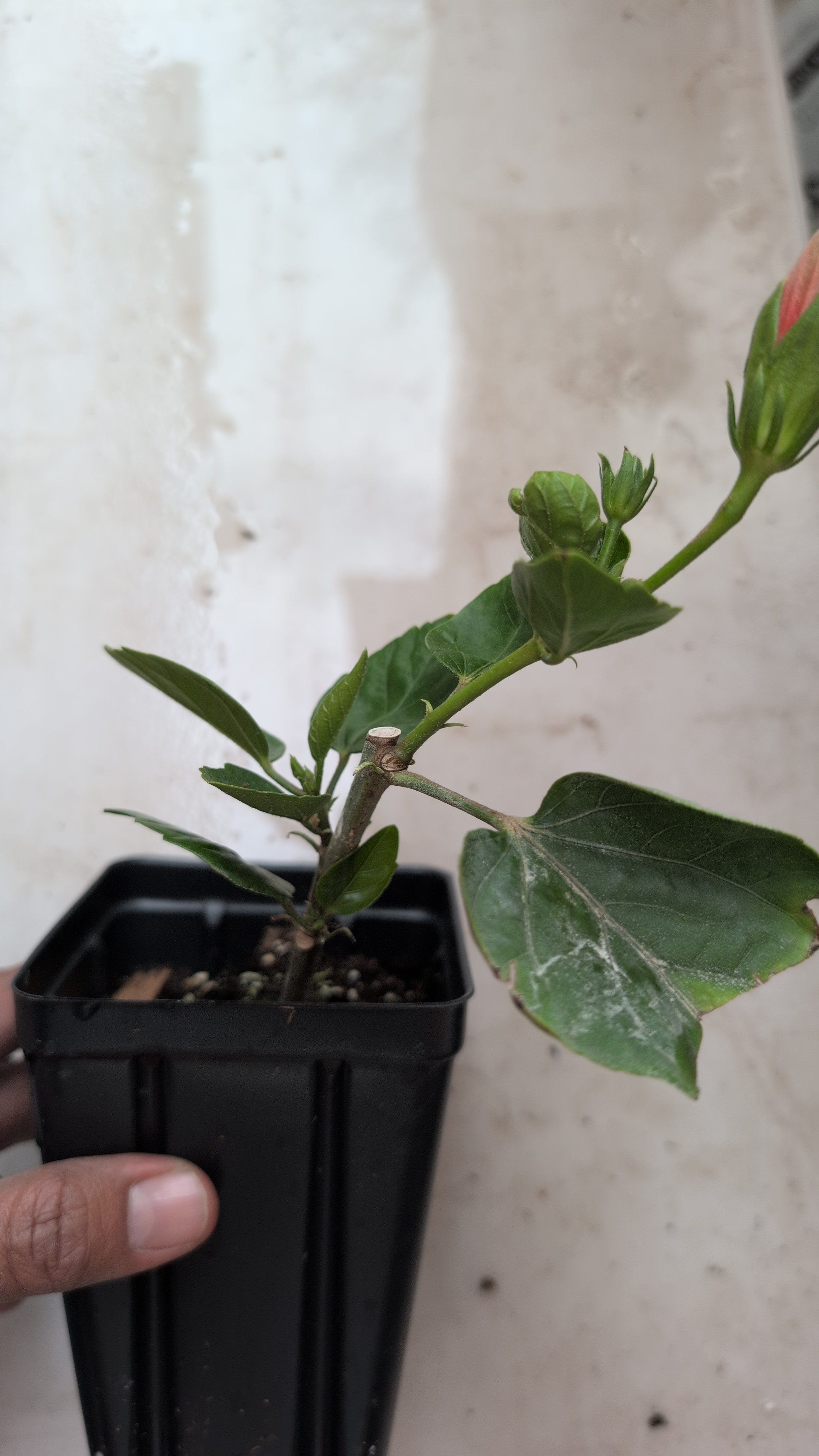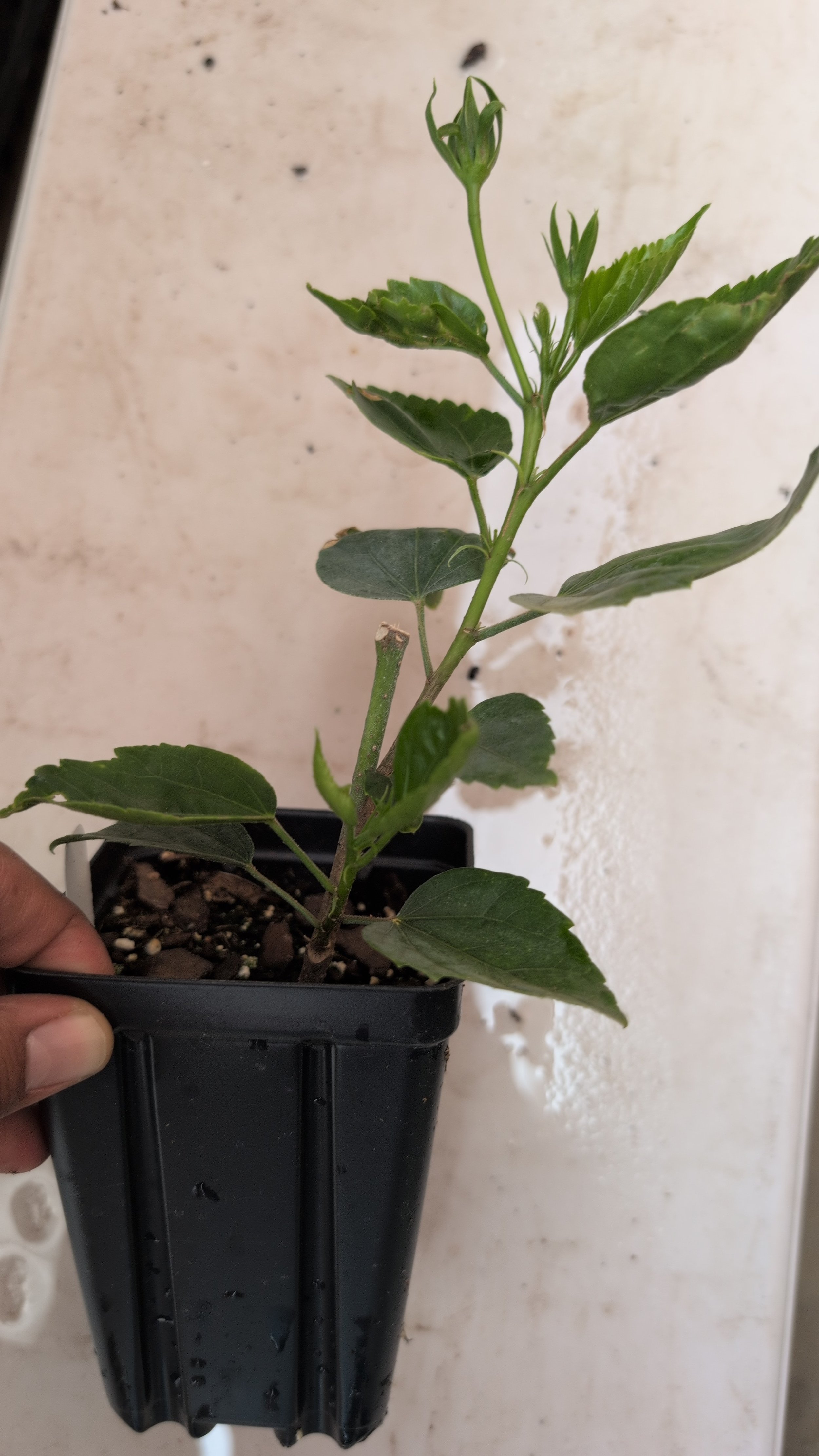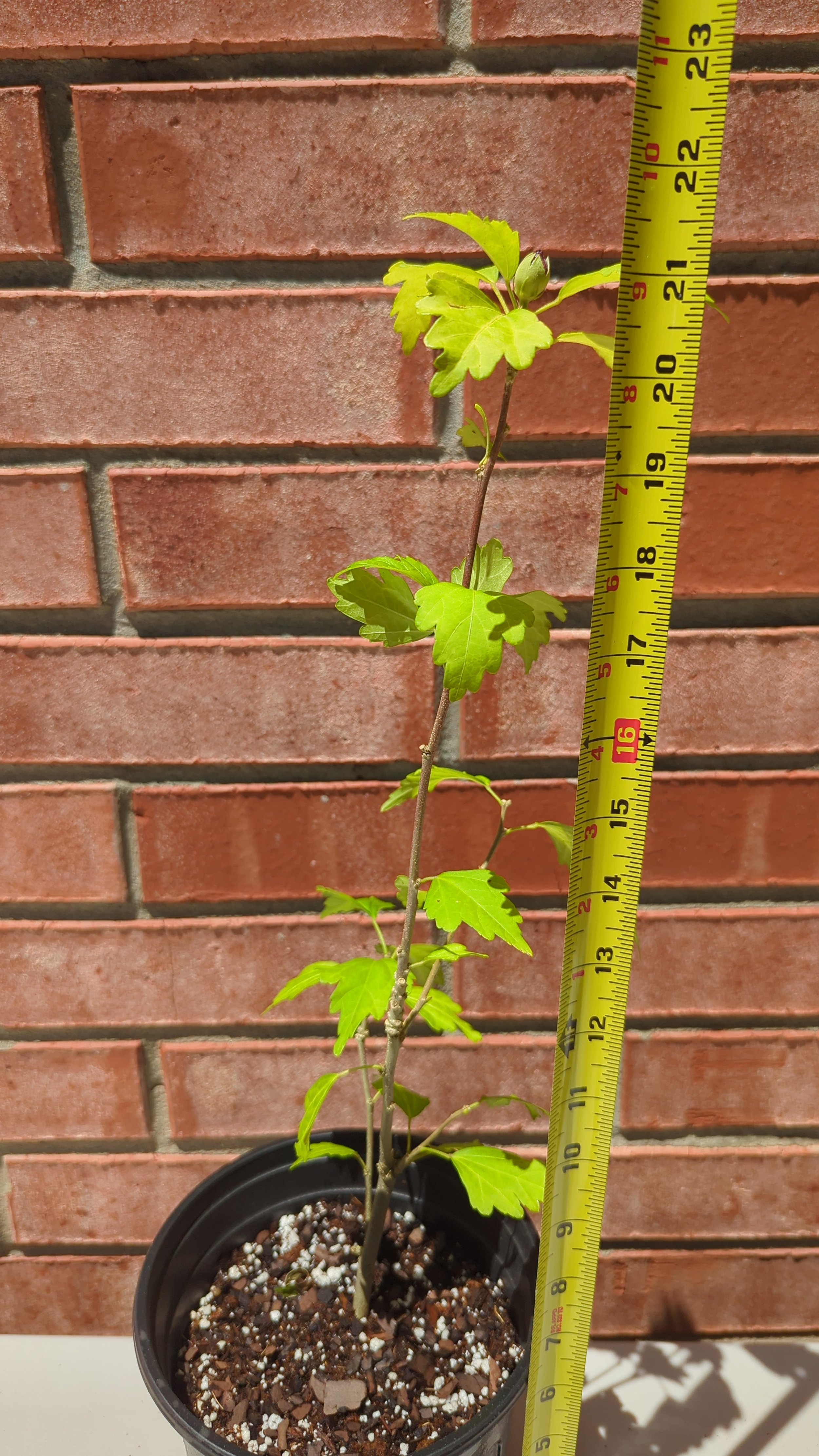 Image 1 of 3
Image 1 of 3

 Image 2 of 3
Image 2 of 3

 Image 3 of 3
Image 3 of 3




Hibiscus - Double Red
Plant is in deep 4-inch container;
Double Red Tropical Hibiscus Plant
Vibrant Red Blooms: The most striking feature is its large, eye-catching, deep red flowers. These blooms are typically trumpet-shaped and can reach up to 6 inches (15 centimeters) in diameter.
Tropical Appearance: Like other tropical hibiscus, it has a lush, tropical look with glossy, dark green foliage that provides a beautiful contrast to the bright red flowers.
Warm Climate Preference: It thrives in warm, humid climates and is typically hardy in USDA zones 9-11, where temperatures rarely drop below 20°F (-6°C). In cooler climates, it's often grown in containers and brought indoors for the winter.
Flowering Period: It typically blooms throughout the warm months of the year, attracting pollinators like butterflies and hummingbirds. Regular deadheading (removing spent flowers) can encourage more continuous blooming.
Size and Growth Habit: The 'Double Red' hibiscus is usually a medium to large-sized shrub, reaching heights of 4 to 8 feet (1.2 to 2.4 meters) and a spread of 3 to 6 feet (0.9 to 1.8 meters) at maturity. It has an upright, bushy growth habit and can be trained as a single-trunk tree or maintained as a multi-stemmed shrub.
Versatile Use: It's a popular choice for adding a splash of color to landscapes, gardens, and patios. It can be used in hedges, borders, containers, or as a standout specimen plant.
Care Requirements: Sunlight: Prefers full sun, needing at least 6 to 8 hours of direct sunlight daily for vigorous growth and abundant flowering. It can tolerate some partial shade, especially in the hottest part of the day, but too much shade can reduce flowering. Soil: Requires well-drained, fertile soil with good moisture retention. Watering: Has moderate water needs and prefers evenly moist soil. Water deeply when the top inch of soil feels dry, but avoid overwatering, which can lead to root rot. Pruning: Generally low-maintenance, but occasional pruning can help maintain its shape, size, and encourage new blooms. Remove any dead, damaged, or crossing branches as needed. Fertilizing: Benefits from a balanced fertilizer in the spring to support healthy growth and flowering.
Plant is in deep 4-inch container;
Double Red Tropical Hibiscus Plant
Vibrant Red Blooms: The most striking feature is its large, eye-catching, deep red flowers. These blooms are typically trumpet-shaped and can reach up to 6 inches (15 centimeters) in diameter.
Tropical Appearance: Like other tropical hibiscus, it has a lush, tropical look with glossy, dark green foliage that provides a beautiful contrast to the bright red flowers.
Warm Climate Preference: It thrives in warm, humid climates and is typically hardy in USDA zones 9-11, where temperatures rarely drop below 20°F (-6°C). In cooler climates, it's often grown in containers and brought indoors for the winter.
Flowering Period: It typically blooms throughout the warm months of the year, attracting pollinators like butterflies and hummingbirds. Regular deadheading (removing spent flowers) can encourage more continuous blooming.
Size and Growth Habit: The 'Double Red' hibiscus is usually a medium to large-sized shrub, reaching heights of 4 to 8 feet (1.2 to 2.4 meters) and a spread of 3 to 6 feet (0.9 to 1.8 meters) at maturity. It has an upright, bushy growth habit and can be trained as a single-trunk tree or maintained as a multi-stemmed shrub.
Versatile Use: It's a popular choice for adding a splash of color to landscapes, gardens, and patios. It can be used in hedges, borders, containers, or as a standout specimen plant.
Care Requirements: Sunlight: Prefers full sun, needing at least 6 to 8 hours of direct sunlight daily for vigorous growth and abundant flowering. It can tolerate some partial shade, especially in the hottest part of the day, but too much shade can reduce flowering. Soil: Requires well-drained, fertile soil with good moisture retention. Watering: Has moderate water needs and prefers evenly moist soil. Water deeply when the top inch of soil feels dry, but avoid overwatering, which can lead to root rot. Pruning: Generally low-maintenance, but occasional pruning can help maintain its shape, size, and encourage new blooms. Remove any dead, damaged, or crossing branches as needed. Fertilizing: Benefits from a balanced fertilizer in the spring to support healthy growth and flowering.
Plant is in deep 4-inch container;
Double Red Tropical Hibiscus Plant
Vibrant Red Blooms: The most striking feature is its large, eye-catching, deep red flowers. These blooms are typically trumpet-shaped and can reach up to 6 inches (15 centimeters) in diameter.
Tropical Appearance: Like other tropical hibiscus, it has a lush, tropical look with glossy, dark green foliage that provides a beautiful contrast to the bright red flowers.
Warm Climate Preference: It thrives in warm, humid climates and is typically hardy in USDA zones 9-11, where temperatures rarely drop below 20°F (-6°C). In cooler climates, it's often grown in containers and brought indoors for the winter.
Flowering Period: It typically blooms throughout the warm months of the year, attracting pollinators like butterflies and hummingbirds. Regular deadheading (removing spent flowers) can encourage more continuous blooming.
Size and Growth Habit: The 'Double Red' hibiscus is usually a medium to large-sized shrub, reaching heights of 4 to 8 feet (1.2 to 2.4 meters) and a spread of 3 to 6 feet (0.9 to 1.8 meters) at maturity. It has an upright, bushy growth habit and can be trained as a single-trunk tree or maintained as a multi-stemmed shrub.
Versatile Use: It's a popular choice for adding a splash of color to landscapes, gardens, and patios. It can be used in hedges, borders, containers, or as a standout specimen plant.
Care Requirements: Sunlight: Prefers full sun, needing at least 6 to 8 hours of direct sunlight daily for vigorous growth and abundant flowering. It can tolerate some partial shade, especially in the hottest part of the day, but too much shade can reduce flowering. Soil: Requires well-drained, fertile soil with good moisture retention. Watering: Has moderate water needs and prefers evenly moist soil. Water deeply when the top inch of soil feels dry, but avoid overwatering, which can lead to root rot. Pruning: Generally low-maintenance, but occasional pruning can help maintain its shape, size, and encourage new blooms. Remove any dead, damaged, or crossing branches as needed. Fertilizing: Benefits from a balanced fertilizer in the spring to support healthy growth and flowering.

















